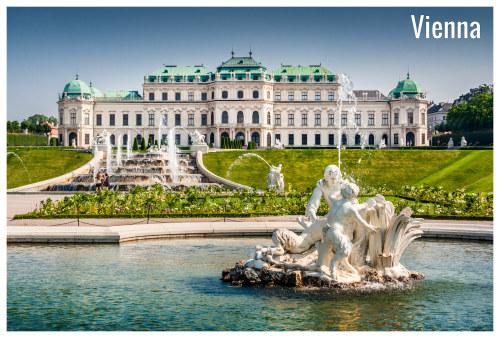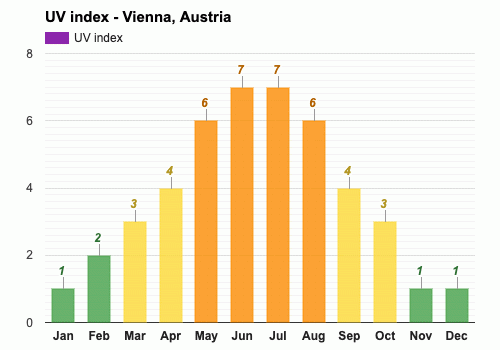Contents
- The climate of Vienna
- The best time to visit Vienna
- The worst time to visit Vienna
- Spring weather in Vienna
- Summer weather in Vienna
- Autumn weather in Vienna
- Winter weather in Vienna
- Weather in January
- Weather in February
- Weather in March
- Weather in April
- Weather in May
- Weather in June
- Weather in July
- Weather in August
- Weather in September
- Weather in October
- Weather in November
- Weather in December
- Frequently asked questions
- Average temperature
- Average rainfall
- Average rainfall days
- Average snowfall
- Average daylight
- Average sunshine
- Average UV index

The climate of Vienna
Temperature fluctuations range from freezing lows of -0.8°C (30.6°F) in the heart of winter, to balmy evenings with lows of 17.4°C (63.3°F) in the comfort of summer. Similarly, daytime highs have a large amplitude of variances, swinging from an icy 3.8°C (38.8°F) in the cold months to a sun-drenched 26.7°C (80.1°F) in the summertime.
Rainfall does not seem to have a favored season. Its distribution over twelve months stays within the bracket of 21mm (0.83") to 67mm (2.64"), with no discernible pattern or bias to a certain part of the year. Snow, however, sticks strictly to the colder months with zero presence from May to October. The most substantial amount of snowfall, 186mm (7.32"), gives a white coat to Vienna in January. It is worth noting that the hours of sunshine and daylight exhibit a clear routine; the shortest days with 8.4 hours of daylight occur in December while the longest, reaching up to 16 hours, are seen in June.
The best time to visit Vienna
The worst time to visit Vienna
Spring weather in Vienna
Summer weather in Vienna
Autumn weather in Vienna
Winter weather in Vienna
Weather in January
Weather in February
Weather in March
Weather in April
Weather in May
Weather in June
Weather in July
Weather in August
Weather in September
Weather in October
Weather in November
Weather in December
Published by: Weather Atlas | About Us
Data Sources | Weather Forecasting & Climate
Frequently asked questions
What month is the coldest in Vienna?
What is the driest month in Vienna?
How many days does it rain in Vienna?
When does it snow in Vienna?
What is the snowiest month in Vienna?
How much does it snow in Vienna?
When is the lowest UV index in Vienna?
When it does not snow in Vienna?
When are the longest days in Vienna?
What is the month with the highest UV index in Vienna?
What part of the year is the hottest in Vienna?
What is the wettest month in Vienna?
What month has the most sunshine in Vienna?
When is Daylight Saving Time (DST) in Vienna?
What is the month with the shortest days in Vienna?
What is the month with the least sunshine in Vienna?
Average temperature
Vienna, Austria

The warmest month (with the highest average high temperature) is July (26.7°C).
The month with the lowest average high temperature is January (3.8°C).
The month with the highest average low temperature is August (17.5°C).
The coldest month (with the lowest average low temperature) is January (-0.8°C).
Average rainfall
Vienna, Austria

- Average rainfall in January:
21.3mm - Average rainfall in February:
29.3mm - Average rainfall in March:
39.1mm - Average rainfall in April:
39.2mm - Average rainfall in May:
60.9mm - Average rainfall in June:
63.3mm
- Average rainfall in July:
66.6mm - Average rainfall in August:
66.5mm - Average rainfall in September:
50.4mm - Average rainfall in October:
32.8mm - Average rainfall in November:
43.9mm - Average rainfall in December:
34.6mm
The wettest month (with the highest rainfall) is July (66.6mm).
The driest month (with the least rainfall) is January (21.3mm).
Average rainfall days
Vienna, Austria

- Average rainfall days in January:
5.3 days - Average rainfall days in February:
6 days - Average rainfall days in March:
8.1 days - Average rainfall days in April:
6.3 days - Average rainfall days in May:
8.3 days - Average rainfall days in June:
9.3 days
- Average rainfall days in July:
8.2 days - Average rainfall days in August:
8.5 days - Average rainfall days in September:
6.9 days - Average rainfall days in October:
6 days - Average rainfall days in November:
7.5 days - Average rainfall days in December:
7.6 days
The month with the highest number of rainy days is June (9.3 days).
The month with the least rainy days is January (5.3 days).
Average snowfall
Vienna, Austria

The month with the highest snowfall is January (186mm).
The months with the least snowfall are May, June, July, August, September and October (0mm).
Average daylight / Average sunshine
Vienna, Austria

- Average daylight in January:
8h and 5min - Average daylight in February:
10h and 1min - Average daylight in March:
11h and 5min - Average daylight in April:
13h and 4min - Average daylight in May:
15h and 1min - Average daylight in June:
16h and 0min
- Average daylight in July:
15h and 4min - Average daylight in August:
14h and 2min - Average daylight in September:
12h and 4min - Average daylight in October:
10h and 5min - Average daylight in November:
9h and 2min - Average daylight in December:
8h and 2min
The month with the longest days is June (Average daylight: 16h and 0min).
The month with the shortest days is December (Average daylight: 8h and 24min).
- Average sunshine in January:
2h and 2min - Average sunshine in February:
3h and 4min - Average sunshine in March:
4h and 4min - Average sunshine in April:
6h and 4min - Average sunshine in May:
7h and 4min - Average sunshine in June:
7h and 5min
- Average sunshine in July:
8h and 3min - Average sunshine in August:
8h and 1min - Average sunshine in September:
6h and 1min - Average sunshine in October:
4h and 2min - Average sunshine in November:
2h and 1min - Average sunshine in December:
1h and 4min
The month with the most sunshine is July (Average sunshine: 8h and 30min).
The month with the least sunshine is December (Average sunshine: 1h and 42min).
Average UV index
Vienna, Austria

The months with the highest UV index are June and July (UV index 7).
The months with the lowest UV index are January, November and December (UV index 1).
Vienna, Austria
Weather forecast for your location
2. Allow the app to use your location


